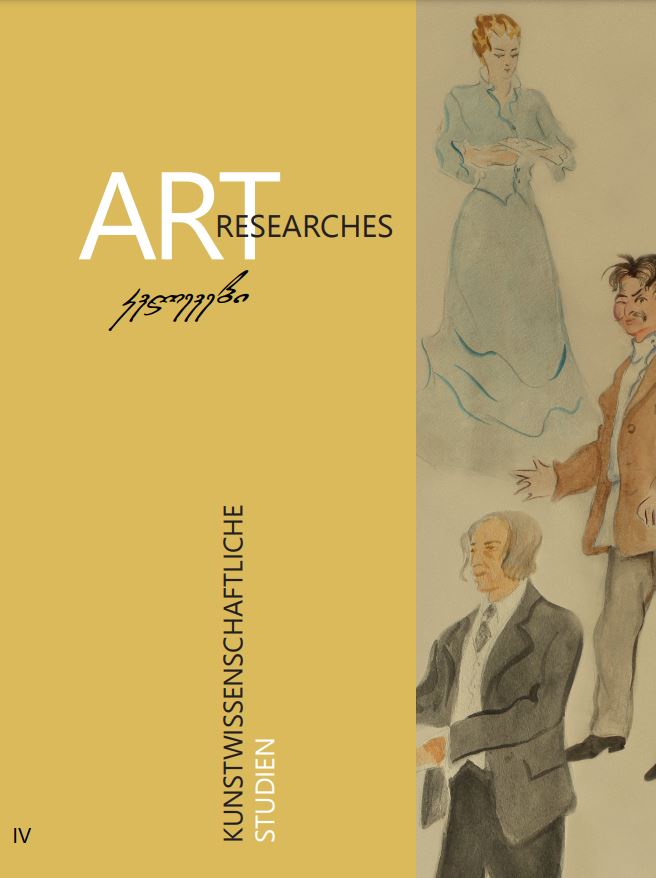The Dance Dialect Of Meskheti-Javakheti
Main Article Content
Abstract
The region of Meskheti-Javakheti has always been rich in the dance property of the round dances. The considerable contribution of the ethnomusicologist Valerian Maghradze in researching and describing the musical folklore of Meskheti-Javakheti deserves special mention. The architectonics of most round dances shows the following structure: 1) introduction – a slow part called “Dideba” i.e. “boasting”, called by the researcher L. Gvaramadze as “Dondgali” i.e. “evenly swinging back and forth”; 2) second part – the actual core of the round dance, called “To join in”; 3) third part – called “Zkvituri” i.e. “to perform hurriedly”. The third part is where the dance in the round dance begins.
The most famous and widespread round dance in the Meskheti-Javakheti region is “Mumli- Mukhasa” i.e. “The mosquito and the oak”. The round dance was traditionally performed in the last week before the beginning of the Great Lent. This round dance is associated with the age-old cultural tradition as well as the theme of patriotism, which was added in the later period. The dance architectonics and dance lexis of this round dance can be described as follows: one-storey round dance performed by men holding hands, all turning in a circle, the movements repeated by the chorus (as a responsory) in successive steps – two on the right, one on the left. Like this round dance, the round dance “Der Schmiedemeister” is also performed in the similar dance lexicon. This round dance was also performed in the last week before the beginning of Great Lent, i.e. before the play Berikaoba (Berikaoba is an improvised mask theatre in Georgia, which goes back to the pagan festival of fertility and rebirth). But there is also a difference between them – in the “blacksmith’s master” round dance, in which several dancers took part, there were also men and women who held each other arm over arm, according to ethnographers (V. Samsonadze thinks that the round dance was performed in the arm-in-arm interlocked position). Moreover, several layers could be formed in the round dance, according to the form – circle within a circle. Both round dances – “The Mosquito and the Oak” and “The Master Blacksmith” – begin with the introductory part “Dideba” – “Boasting”.
Many round dances were performed at weddings in the Meskheti-Javakheti region. When the newlyweds arrived in the groom’s family, they were welcomed with the miXed round dance (performed by women and men) with musical accompaniment. The round dance was slow - three steps right, two – left. The round dance was performed in three or seven rounds, the number of participants was not limited. Round dances were also danced during the procession of newlyweds from the church - the round dances were danced by the bride’s and groom’s entourage, in the middle of the circle was the bagpiper or singers.
In the Meskheti-Javakheti region, as well as in the Racha, Kartli, Kakheti and mountain regions of eastern Georgia, it was customary to bypass the domestic hearth three times in the round dance. Such rounds included “bless the leader”. Although a round dance of this name does not occur in Meskheti-Javakheti. In contrast to other regions of Georgia, in the area of Meskheti-Javakheti that I am researching, one finds the following symptomatic round dance – “round dance of seven couples”. This dance was also performed at weddings by the bride and groom and six unmarried couples. The dance was accompanied by musical instruments – zurna and duduk (double reed instrument with a funnel-shaped bell and a woodwind instrument with an extremely large double reed). The seven couples circumvent seven circles with lit candles in their hands, starting therefore the round dance should be slow and full of balance. The groom’s hunting rite was also accompanied by round dance.
Among the lost examples of Meskheti-Javakheti dance folklore is the round dance “Dsaghluri” – this round dance was also danced in the weddings. A dialect variant of the round dance “Dsaghluri” (a play that has also disappeared) has been preserved in some regions of Georgia. This play is associated with the cult of fertility and was therefore primarily performed at weddings. This round dance is also known as “Lalioni” (the name is of Turkish origin), which means a mime dance (round dance to be performed silently).
In addition to the one-storey rounds, two-storey rounds are also found in the dance folklore of Meskheti-Javakheti, such as the “Samkrelo” round. Three steps forward (right), two steps back (left) – this structure is also found in the round dance song “Go around in a circle now”.
Vardzioba – Dzioba”, which also begins with the part “boasting”, and then continues with a dance duet of a couple, counts as a round dance.
Particularly noteworthy is the scenic choreographic contribution of G. Salukvadze, who based himself on artefacts, displaying his own individual concept in the performance of the dances – “Idumala”, “Mdzimuri”, “Dideba”, “VardziobaDzioba”. Each of these dances has a patriotic content, at the centre of the subject is the fight with the enemy.
In Meskheti-Javakheti, the following dances are evidenced – “Lekuri” and “Baghdaduri”, which can be danced solo or in pairs. The article also places special emphasis on the choreological terminology that is characteristic of this region.
